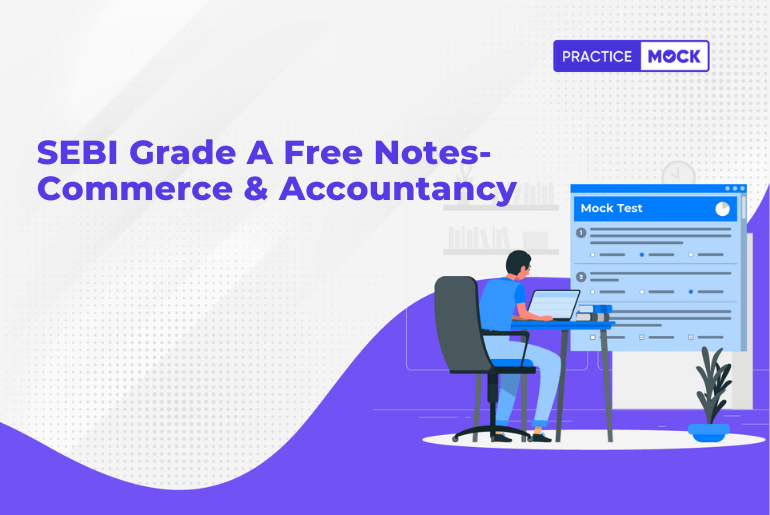We are bringing you Free Notes of SEBI Grade A Phase II. Now that the Phase I exam is over, your preparation Phase II must be going on in full speed. To help you with your preparation, we are providing you free PDFs of Commerce & Accountancy in this article. Have a look:
Buy SEBI Grade A Phase 2 Package Now
- Accounting as a financial information system (Accounting as a Financial Information System, Scope of Accounting, Role of Accounting, Accounting as an Information System, Role and Activities of an Accountant, Accounting Personnel)
- Accounting Standards with specific reference to Accounting for Depreciation, Inventories, Revenue Recognition, Fixed Assets, Foreign Exchange Transactions, Investments (Accounting Standards, Need for Accounting Standards, AS 2: Valuation of Inventories, Applicability, Non-Applicability, Valuation of Inventories, Calculating Cost of Inventory, Cost formula, Disclosures to be made, AS 9: Revenue Recognition, Applicability, Non-Applicability, Criteria for recognizing revenue, Disclosures to be made, AS 10: Property, Plant and Equipment, Applicability, Non-Applicability, Definitions, Recognition, Measure at recognition, Measurement after recognition, Accounting for Revaluation, Depreciation, Retirements, De-recognition, Disclosures to be made, AS 11: The Effects of Changes in Foreign Exchange Rates, Definitions, Foreign Currency Transaction, Recognizing Exchange Difference, Foreign Operations, Translation of Integral Operation, Translation of Non-Integral Operation, Recognizing Exchange Difference, Para 46 and 46A, Forward Exchange Contracts, Contract not intended for trading or speculation purposes, Other Contract, Disclosures to be made, AS 13: Accounting for Investments, Applicability, Non-Applicability, Definitions, Cost of an investment, Adjustments in certain cases, Valuation/Carrying amount of Investments, Re-classification of Investments, Disposal of Investments≤ Disclosures to be made)
- Cash Flow Statement, Fund flow statement, Financial statement analysis; Ratio analysis (Balance Sheet, Format of a Balance Sheet, Contents of the Balance Sheet, A. Equity and Liabilities, B. Assets, Statement of a Profit and Loss Account, Format of a Statement of a Profit and Loss Account, Contents of the Profit and Loss Account, A. Income, B. Expenses, C. Exceptional Items, D. Extraordinary Items, E. Tax Expenses, F. Profit / (loss) for the period from discontinuing operations, G. Tax expenses of discontinuing operations, H. Earnings per equity shares, Final Comments)
- Accounting for Share Capital Transactions including Bonus Shares, Right Shares (Accounting for Share Capital, Classification of companies, Private Company, Public Company, One Person Company, Share Capital of a Company, Categories of Share Capital, Classes of Shares, Preference Shares, Equity Shares, Accounting Treatment, Accounting treatment for Issue of Shares in cash, Issue of Shares at a premium, Issue of Shares at a discount, Calls in Arrears, Calls in Advance, Over Subscription, Under Subscription, Forfeiture of shares, Re-Issue fo Forfeited Shares, Issue of shares for consideration other than cash, Issue of Right Shares, Issue of Bonus Shares)
- Employees Stock Option and Buy-Back of Securities (Buy-Back of Securities, Sources of buy-back, Conditions for buy-back of shares, Advantages of buy-back, Calculation of Capital Redemption Reserves and Net Proceeds from Fresh Issue, Illustration, Employee Stock Options (ESOP), Objective of issuing an ESOP, Useful definitions, Condition for the issue of ESOP, Method for Implementing ESOP, Accounting treatment and valuation methods, Illustration & Solution)
- Preparation and Presentation of Company Final Accounts (Balance Sheet, Format of a Balance Sheet, Contents of the Balance Sheet, A. Equity and Liabilities, B. Assets, Statement of a Profit and Loss Account, Format of a Statement of a Profit and Loss Account, Contents of the Profit and Loss Account, A. Income, B. Expenses, C. Exceptional Items, D. Extraordinary Items, E. Tax Expenses, F. Profit / (loss) for the period from discontinuing operations, G. Tax expenses of discontinuing operations, H. Earnings per equity shares, Final Comments)
Buy SEBI Grade A Phase 2 Package Now
We hope that the above notes will be helpful in your preparation.
- Sign Up on Practicemock for Updated Current Affairs, Free Topic Tests and Free Mini Mocks
- Sign Up Here to Download Free Study Material
Free Mock Tests for the Upcoming Exams
- RRB PO 2024 Free Mock Test
- RRB Clerk 2024 Free Mock Test
- SSC MTS Free Mock Test
- SSC CHSL Free Mock Test
- SSC CGL Free Mock Test
- GATE Mechanical Free Mock Test
- GATE Civil Free Mock Test
- NABARD Gr. A Free Mock Test
- SBI Clerk Mains Free Mock Test
- SSC CPO Free Mock Test
- AFCAT Free Mock Test
- CAT Free Mock Test
- NIACL Assistant Free Mock Test
- UIIC AO Free Mock Test
- UIIC Assistant Free Mock Test
- GIC Assistant Manager Free Mock Test
- NICL AO Free Mock Test
- Free SSC Live Test
- UPSC CSAT Free Mock Test
- CDS-I Free Mock Test
- RRB ALP Free Mock Test


